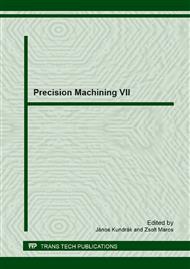[1]
O. Music, J. M. Allwood, K. A. Kawai. A review of the mechanics of metal spinning. In Journal of Materials Processing Technology. Vol. 210 (2010), Iss. 1, p.3 – 23.
DOI: 10.1016/j.jmatprotec.2009.08.021
Google Scholar
[2]
W. C. Emmensa, G. Sebastianib, A. H. van den Boogaardc. The technology of Incremental Sheet Forming—A brief review of the history. Journal of Materials Processing Technology. Vol. 210 (2010), p.981 – 997.
DOI: 10.1016/j.jmatprotec.2010.02.014
Google Scholar
[3]
L. Wang, H. Long. A study of effects of roller path profiles on tool forces and part wall thickness variation in conventional metal spinning. Journal of Materials Processing Technology, Vol. 211(2011), p.2140– 2151.
DOI: 10.1016/j.jmatprotec.2011.07.013
Google Scholar
[4]
C. C. Wong, T. A. Dean, J. Lin. A review of spinning, shear forming and flow forming processes. Int. J. of Machine Tool & Manufacture, Vol. 43, 2003, No. 14, p.1419 – 1435.
DOI: 10.1016/s0890-6955(03)00172-x
Google Scholar
[5]
E. Quigley, J. Monaghan. Metal forming: an analysis of spinning processes. Journal of Materials Processing Technology, Vol. 103 (2000), No. 1, p.114 – 119.
DOI: 10.1016/s0924-0136(00)00394-0
Google Scholar
[6]
L. Wang, H. et al. Effects of roller feed ratio on wrinkling failure in conventional spinning of a cylindrical cup. Proceedings of the Institution of Mechanical Engineers, Part B, Journal of Engineering Manufacture. Vol. 225 (2011).
DOI: 10.1177/0954405410396024
Google Scholar
[7]
L. Wang. Analysis of Material Deformation and Wrinkling Failure in Conventional Metal Spinning Process. Durham theses. (2012) Durham University. Available at Durham E-Theses Online: http: /etheses. dur. ac. uk/3537/ [Accessed October 2012].
Google Scholar
[8]
P. Šugár, J. Šugárová, P. Zemko. Strain and strain-hardening analysis of formed parts produced by multi-pass metal spinning. In: Tehnicki Vjesnik - Technical Gazette. Vol. 19 (2012), No. 1, p.111 – 114. ISSN 1330-3651.
DOI: 10.4028/www.scientific.net/kem.622-623.427
Google Scholar
[9]
J. Šugárová, P. Šugár, P. Zemko. Metal spun and deep drawn part´s surface layers properties evaluation. In: Journal of Production Engineering. Vol. 14 (2011), No. 1, p.35 – 38. ISSN 1821-4932.
Google Scholar
[10]
H. Diering. CNC spinning using adaptive control. VDI Fortschrittberichte, R. 2, No. 252. VDI-Verlag, Düsseldorf.
Google Scholar
[11]
R. K. Roy. Design of Experiments Using the Taguchi Approach. 16 steps to product and process improvements, John Wiley&Sons, New-York (2001).
Google Scholar


